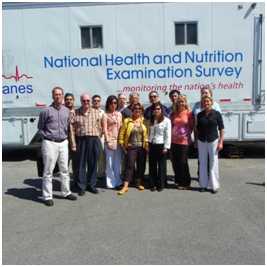
What's New
New Tutorial
The Environmental Chemical Data Tutorial was published online this summer. It includes four courses on the Environmental Chemical Data: Survey Orientation, Preparing an Analytic Dataset, Critical Issues for the Analysis, and Data Analyses. The tutorial covers topics pertinent to environmental chemical data, such as the limit of detection, multi-year issues, the use of subsample weights, and other caveats of data analyses.
Asian Oversample Preparations
As NHANES prepares to oversample Asians from 2011-2014, work is well under way for including this culturally and linguistically diverse group into the survey. On-going activities related to the Asian oversample include: 1) Outreach and critical survey materials are being translated into Chinese, Korean and Vietnamese; 2) Partnerships with various organizations, such as The Asian and Pacific Islander American Health Forum (APIAHF), are being formed for advice and better outreach to various Asian communities; 3) Advance survey arrangements now include actively seeking out help from and connecting with the Asian communities; 4) Cultural diversity and competency training are being added to the field staff’s annual training; and 5) Various interpretation services are being explored for better serving the non-English speaking participants throughout the whole survey process.
Field Trip: NHANES Staff Visit the MEC and New Lab Trailer
Recently the NHANES Mobile Examination Center (MEC) trailers were parked within driving distance from headquarters, so many NHANES staff took advantage of this rare proximity. For a few staff members, this was their first glimpse of this impressive state-of-the-art MEC for the first time. Others were eager to see the brand new lab trailers just integrated in the last year.

Informatics Branch staff pose in front of the Mobile Examination Center after their tour.
The Informatics Branch even organized a day trip for its entire staff to have a guided tour of each of the exam components. “It really brings home the complexity and the demands of the examination process”, one staff member commented. Others marveled at how skillfully all components had to be organized and flow. Most of them walked away with much better idea of how the data were collected in the field, and gained much appreciation of the work by the field staff.
NHANES Highlights from the 2010 National Conference on Health Statistics
The National Conference on Health Statistics took place at the Omni Shoreham Hotel in Washington, D.C. from August 16th-18th. This year marks the 50th anniversary of the National Center for Health Statistics. Celebrations were featured not only in the various exhibitions, but also in some very interesting sessions with prominent speakers. Two NHANES sessions on Innovative Study Designs and Child Obesity from the conference are highlighted below (in case you didn’t get a chance to attend in person).
Innovative Study Designs in Health Measures Data Collection, chaired by Lew Berman from the NHANES program, was a well-attended session on Aug 18th. The session highlighted biometric data collection at the city and state levels and in special populations. First, Dr. Lorna Thorpe, an Associate Professor at the City University of New York, School of Public Health at Hunter College, described her experience and some findings from the New York City Health and Nutrition Examination Survey (NYC HANES). NYC HANES is the first example of a health measures study modeled after NHANES to collect data at the sub-national level. Next, Dr. Javier Nieto, Chair of the Department of Population Health Sciences at the University of Wisconsin, described the Survey of the Health of Wisconsin (SHOW). SHOW is designed to collect state-level data, and uses both clinics and mobile examination centers. Lastly, Dr. Katherine Baicker, Professor of Health Economics at the Harvard School of Public Health, gave a presentation on the Oregon Health Study (OHS). The OHS is focused on the potential for assessing the effects of health insurance on individuals’ access to and utilization of health care. The session generated quite a bit of interest and enthusiastic discussion among the participants, and truly signified the value of collaborative efforts and knowledge sharing between NHANES and various partners.
The session on Childhood Obesity provided a panorama from four distinctive perspectives. Dr. Cynthia Ogden, an expert researcher on obesity from the NHANES program who organized the session, started the session with the epidemiological perspective. Dr. Ogden presented the NHANES data on obesity among pre-school age children, school age children and adolescents, pointing out the scope of this public health issue and recent trends. The clinical perspective was presented by Dr. Sandra Hassink, who described the reality of feeding and raising children in today’s environment. Her case studies drove home the difficult challenges families face in raising healthy children, including prevention and intervention strategies from the clinical world. Dr. Eduardo Sanchez focused his presentation on prevention programs at the state level, while Dr. Shale Wong outlined the federal government’s initiatives. Dr. Wong introduced First Lady Michelle Obama’s Let’s Go Initiative, which has put the spotlight on childhood obesity. The Let’s Move! Initiative is a collaborative and community-oriented campaign that addresses various factors that lead to childhood obesity. Dr. William Dietz from CDC, who chaired the session, masterfully conducted this session by giving a thought-provoking presentation and moderating a lively discussion.
New Publications
- Recent Trends in the Prevalence of High Blood Pressure and its Treatment and Control, 1999-2008
- Prevalence of Underweight Among Adults Aged 20 Years and Over: United States, 2007-2008
- Prevalence of Underweight Among Children and Adolescents: United States, 2007-2008
- Prescription Drug Use Continues to Increase: U.S. Prescription Drug Data for 2007-2008